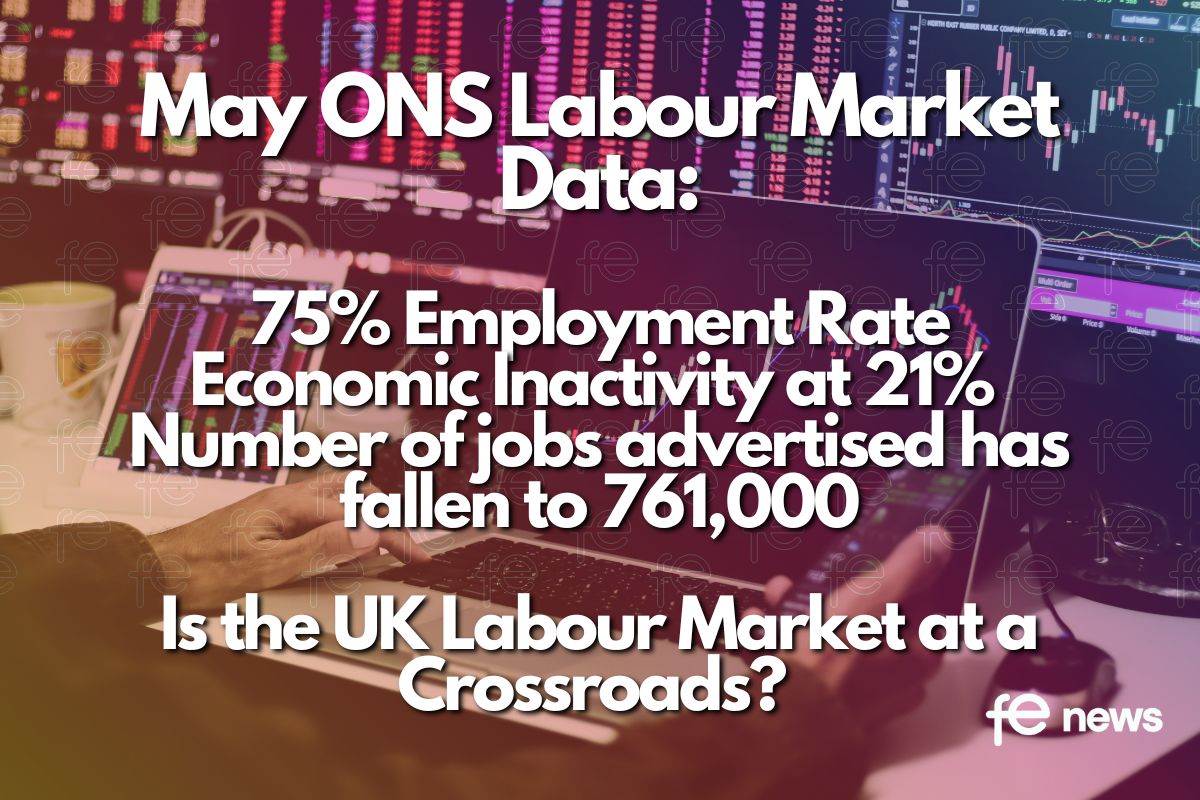ONS Labour Market data June 24: Unemployment highest for 2 years and Economic inactive rate is at 22.3%. Sector Reaction

The ONS Labour Market data has been released for June 2024. With more than a fifth of working-age adults (22.3%) in the UK are not actively looking for work and unemployment has risen to 4.4% which is the highest level for three years.
More than 1 million workers less than pre-Pandemic
The UK employment rate (for people aged 16 to 64 years) was estimated at 74.3% in February to April 2024, below estimates of a year ago, and is now only slightly above the pandemic low point of 74.1 per cent, set in winter 2021. The huge 1.9 percentage point fall from the UK’s pre-pandemic 16-64 employment rate of 76.2 per cent means that, holding population constant, the workforce is more than a million workers smaller. Nye Cominetti, Principal Economist at the Resolution Foundation highlights: “with both unemployment and inactivity up. Worryingly, the UK employment is closer to its mid-pandemic lows, than its pre-pandemic highs”. The Resolution Foundation also calculated that average earnings remain more than £14,000 a year off their pre-financial crisis path after 16 years of wage stagnation
The UK Claimant Count for May 2024 increased on the month and on the year, to 1.629 million. There is now a record 2.83 million people who are economically inactive due to long-term sickness – 702,000 higher than in January-March 2020. In March to May 2024, the estimated number of vacancies in the UK decreased by 12,000 on the quarter to 904,000.
Latest Labour Market Data from ONS
Payrolled employees in the UK decreased by 36,000 (0.1%) between March and April 2024, but rose by 201,000 (0.7%) between April 2023 and April 2024.
The early estimate of payrolled employees for May 2024 decreased by 3,000 (0.0%) on the month but increased by 167,000 (0.6%) on the year, to 30.3 million. The May 2024 estimate should be treated as a provisional estimate and is likely to be revised when more data are received next month.
The UK employment rate (for people aged 16 to 64 years) was estimated at 74.3% in February to April 2024, below estimates of a year ago, and decreased in the latest quarter.
In March 2024, the total Workforce Jobs (WFJ) in the UK estimate rose by 431,000 on the year to 37.2 million, with increases in both employee jobs and self-employment jobs.
The UK unemployment rate (for people aged 16 years and over) was estimated at 4.4% in February to April 2024, above estimates of a year ago, and increased in the latest quarter.
ONS also published the Claimant Count (which are new Experimental Statistics), a measure of the number of people who are receiving a benefit principally for the reason of being unemployed. The UK Claimant Count for May 2024 increased on the month and on the year, to 1.629 million.
The UK economic inactivity rate for people aged 16 to 64 years was estimated at 22.3% in February to April 2024, above estimates of a year ago, and increased in the latest quarter.
In March to May 2024, the estimated number of vacancies in the UK decreased by 12,000 on the quarter to 904,000. Vacancies decreased on the quarter for the 23rd consecutive period but are still above pre-coronavirus (COVID-19) pandemic levels.
Annual growth in employees’ average regular earnings (excluding bonuses) in Great Britain was 6.0% in February to April 2024, and annual growth in total earnings (including bonuses) was 5.9%.
Annual growth in real terms (adjusted for inflation using the Consumer Prices Index including owner occupiers’ housing costs (CPIH)) for regular pay was 2.3% in February to April 2024, and for total pay was 2.2%.
There were an estimated 17,000 working days lost because of labour disputes across the UK in April 2024.
Employability and Skills Sector Reaction to the ONS Labour Market data for June 2024
Responding to the latest ONS figures, Stephen Evans, chief executive at Learning and Work Institute, said:
“The last labour market stats before the election show a further drop in employment and rise in economic inactivity. 3.2 million people are out of work but want a job: the next government needs to widen employment support to all who want to work, given today only 1 in 10 out-of-work disabled people get help to find work each year. Average earnings are rising in real terms as inflation falls, but are a staggering £12,000 per year below what they’d be on pre-financial crisis trends. This shows the scale of catch-up needed in the years ahead.”
Rebecca Florisson, Principal Analyst, the Work Foundation at Lancaster University, a leading think tank for improving working lives in the UK said:
“Today’s labour market data shows there will be no time for complacency for the next Government as the UK has a smaller workforce that is poorer and sicker than in 2019.
“Annual nominal wage growth was 6%, with the record National Living Wage increase of 9.8% improving the pay of 3.3 million low paid workers. There are signs that the wage growth recovery has peaked.
“Despite real wages rising by 2.3% on the year, the economic impact of the Covid-19 pandemic and the war in the Ukraine has made this the first Parliament since 1955 where living standards have declined. The reality is that most people are feeling poorer than when they last voted in the last General Election nearly five years ago.
Facing the challenge of a smaller workforce
“The next Government will face the challenge of a smaller workforce than at the start of the Parliament, with the employment rate 1.9% percentage points lower than in December 2019-February 2020. Today, more than a fifth of working-age adults (22.3%) in the UK are not actively looking for work and unemployment has risen to 4.4% which is the highest level for three years.
“There are now a record 2.83 million people who are economically inactive due to long-term sickness – 702,000 higher than in January-March 2020. The UK continues to be an international outlier with participation rates well below pre-Covid levels and this trend shows no sign of abating.
Challenges facing the next Government
“Grasping the challenge of high levels of economic inactivity – and how it impacts the exchequer, the welfare system and the health of the nation – will be one of the most pressing tasks facing the next Government.
“Over the coming weeks, political parties should focus on how to support more people into sustainable employment, rather than on binary measures of increasing employment or reducing unemployment that ignore the quality and security of jobs available for jobseekers. Instead, their manifestos must prioritise de-risking the journey back into work, through high quality employment support and designing jobs that offer people adequate reward, security, flexibility and progression.”
The ONS has published its latest labour market statistics this morning. The Recruitment and Employment Confederation (REC) Chief Executive Neil Carberry, said:
“Employers played it cool in the face of economic and political uncertainty this Spring. Business surveys suggest this is starting to change, but overall vacancies remained ahead of pre-pandemic levels even during the early months of the year. Businesses tell us they are confident about hiring –but they are watching inflation, interest rates and the General Election for signals on when to go. There has certainly been a marked improvement in mood in the hiring market since Easter.
“The bigger picture is that unemployment and employment numbers remain robust and pay growth is higher than we got used to over the past decade. But the pay data is noisy right now, with a large National Minimum Wage increase and employers 2024 pay settlements still feeding into the numbers.
“The number of people who are economically inactive remains a major challenge. In July, a newly elected government will need to act quickly on labour supply or risk a £39 billion cost to the economy per year because of labour and skills shortages – just short of two whole Elizabeth Lines. All parties should use their manifestos to set out a workforce plan that can help businesses shape our workforce for the future. This should involve lowering barriers on skills, support infrastructure such as childcare and transport, regulation, immigration and tax.”
Matthew Percival, Future of Work and Skills Director, the CBI, said:
“While the labour market continues to slowly cool, it remains very difficult for companies to hire the people they need to grow and pay continues to rise significantly faster than inflation, pushing up prices.
“Labour shortages remain one of the biggest challenges facing businesses. A credible plan to tackle shortages should involve pulling a range of policy levers such as removing barriers to work, supporting investments in technology, building a skills system that supports lifelong learning, and a new approach to immigration.”
Nye Cominetti, Principal Economist at the Resolution Foundation, said:
“The labour market has continued to cool in early 2024, with both unemployment and inactivity up. Worryingly, the UK employment is closer to its mid-pandemic lows, than its pre-pandemic highs.
“Turning around this poor performance, and kickstarting the kind of jobs growth Britain experienced in the 2010s will be a key task for the next government.
“But while the jobs market weakens, pay packets remain resilient. This recent spurt of real wage growth, the strongest in an almost a decade, will be a relief to workers and a worry for the Bank of England. But it can’t be sustained unless productivity picks up.”
TUC General Secretary Paul Nowak said:
“These damning figures show the Conservatives have taken the jobs market from bad to worse.
“Unemployment is rising. Vacancies are falling. Insecure work is at epidemic levels. Record numbers are long-term sick. And wages are still worth less than in 2008.
“The Tories have failed working people. We need a government that will rebuild industry, create wage growth, and deliver a better living for working families.”
Dr Emily Andrews, Deputy Director for Work at the Centre for Ageing Better, said:
“The pandemic stalled two decades of improvement in the employment rate of older age groups and they have not recovered. If employment opportunities stagnate after 50, so too will the UK economy.
“A 75% employment rate target is attainable based on pre-pandemic trends but will require a sustained government focus on the issue. By 2030, there will be an additional 1.2 million people aged 50-64 in the UK, but only another 500,000 people aged 15-29. The future of UK growth and productivity over the next Parliament depends on mobilising the 50+ workforce.
“This is not about special treatment for older workers. This is about fairness and ensuring equal opportunity for older workers seeking employment or wanting to stay in work that will benefit employers, the economy and the whole country.
“By the end of the next Parliament, the State Pension Age is set to rise to 67. It is imperative that we act now to reignite the pre-pandemic momentum and ensure that no segment of our workforce is left behind.”
Tony Wilson, Director at the Institute for Employment Studies, said:
“Three quarters of all employment growth this century has been among people aged over 50 but in the last four years this has ground to a halt. For the first time in three decades, employment among older people has stopped growing.
“Addressing this needs to be a top priority for whoever wins this general election, as helping more older people into work and to stay in work is going to be key to supporting a stronger economy, better public finances and fewer people in poverty.
“A 75% target looks ambitious from where we are now, but it is really the least that we should aim for. We’re currently around 20th in Europe for employment among older people, and around a dozen countries are already at 75% higher. We should be there too.”
Caroline Abrahams, Charity Director at Age UK, said:
“Never before has Britain needed its older workers as it does now. With all the years or experience, knowledge, and wisdom that the 50+ age group can bring, it’s of huge importance that everyone who wants to work is able to do so.
“However, for many people it’s not always that easy. Older workers face many barriers, particularly if they are carers, have a health condition, or have recently found themselves unemployed and looking to retrain. And this is not to mention the ageism that pervades the labour market and prevents many in this age group from fulfilling their potential.
“It’s crucial that the next government looks urgently at how to facilitate more – and better – working in later life, in terms of both enabling people to stay with their existing employer, and to find alternative work if the need arises.
“Without a focused effort that looks explicitly at the barriers faced by older workers, we risk failing to take full advantage of this enormous talent pool, which would be a real tragedy at an individual and a national level.”
Michael Stull, Managing Director, ManpowerGroup UK said:
“Amidst the flurry of funding pledges and policy announcements being made in the lead-up to 4 July, it’s perhaps worth remembering that this general election is fundamentally about people – people who, based on the latest unemployment and economic inactivity numbers released today by the ONS, either aren’t finding work or are unable to work in growing numbers.
“The number of people in the workforce is decreasing which gives us cause for concern. Economic inactivity and unemployment both continue to rise and we also note that this month reports a decrease in payrolled employees,” observes Michael Stull, Managing Director, ManpowerGroup UK.
“Our own research indicates that eight-in-ten UK employers still can’t find workers with the skills they need. Add the UK’s long-standing economic stagnation, high living- and labour costs, low productivity, and high levels of national debt to the mix and the outlook for workers and employers alike isn’t exactly rosy unless action is taken rapidly.
“We think the best way to unlock the future prosperity of the country is to unlock the potential of its people. The UK is going to be left behind otherwise – domestically as well as internationally. Whichever party claims victory on 4 July, we’re calling for more holistic approaches to getting more people into work; new approaches to education, professional and vocational training in order to equip more people with the human- and tech-centric skills associated with the AI roll-out; and the development of a blueprint for moving more workers and employers into higher-value jobs with the capacity to bolster innovation, productivity and competitiveness.”
Jack Kennedy, Senior Economist at Indeed said:
“In the run up to the general election, eyes will be on the strength of the country’s labour market. The latest figures show a now-familiar combination of further cooling in the labour market but stubbornly strong wage growth. Meanwhile a further increase in inactivity underlines the challenge facing the next government in bringing more workers into the labour force.
“Today’s figures are likely to reinforce divisions on the Monetary Policy Committee (MPC) as it weighs the timing of interest rate cuts. Expectations for a June rate cut had already dimmed after April’s sticky services inflation figure, with the general election casting further doubt on an early move.
“The MPC will take some comfort from the fact that regular pay growth didn’t tick higher, with the single-month figure actually dipping in April after the large minimum wage uplift at the start of that month.
“But more timely Indeed data shows an uptick in posted wage growth for new hires, suggesting pay pressures aren’t yet dissipating. The Indeed Wage Tracker rose to a four-month high of 6.5% year-on-year in May. Lower-paid categories continue to see particularly strong posted wage growth, amid tight occupation-specific hiring conditions in categories like childcare, cleaning, retail and hospitality.”
Nicholas Hyett, Investment Manager at Wealth Club, commented;
“Falling employment, rising unemployment and rising economic inactivity do not paint a pretty picture of the UK labour market. Falling vacancies makes those numbers particularly concerning, suggesting there is a genuine lack of demand for staff.
There are some redeeming features – real wage growth for instance remains north of 2% year-on-year – but this is, nonetheless, precisely the kind of sign the Bank of England has suggested it’s been waiting for to start cutting interest rates.”
Jonathan Firth, VP Recruitment Solutions at LHH:
“Following the news that the UK is no longer in recession, it is interesting to see that the UK employment rate decreased in the latest quarter.
“Amid this, employers need to consider the ways in which they are attracting and retaining top talent, above competitive renumeration and benefits packages. The focus should be on ways in which they enable talent to progress and develop their careers within the organisation, and crucially, setting up management teams to be able to confidently deliver on their objectives in both virtual and office environments.
“Where there are new openings and ahead of new talent joining, the onus is on employers to really invest time and energy into how they onboard new team members, as the more thorough the onboarding process, the more likely the talent is going to hit the ground running and stay for the long haul.”











Responses